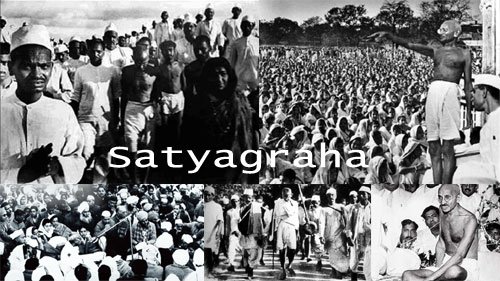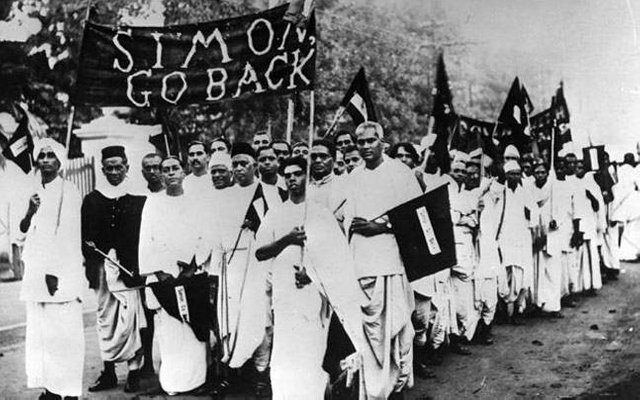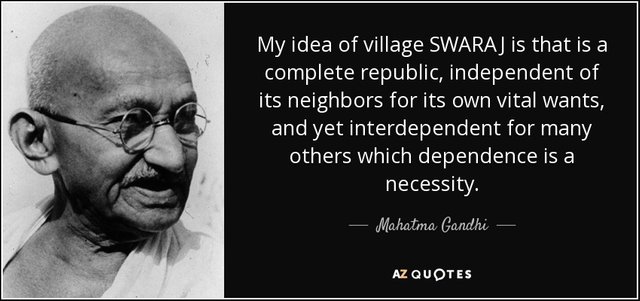Several movements headed by Mahatma Gandhi
Freedom movement and anti-colonial agitation reached a new stage on and beyond 1919. During this time the movements organized by National Congress under the leadership of Mohondas Karamchand Gandhi, started to take the shape of mass movements. Parallelly, peasant and labour movements were being going strong. The leftist political workers and organizations too participated in the anti-colonial struggle. From 1919, Gandhi became the main leader of anti-British movements.

Alongside anti-colonial agitations, there occurred two world wars in the first half of twentieth century. Mahatma Gandhi came back to India during the First World War (1914-19). The First World War had influenced India’s society, polity and economy.
New ideas and planning was seen in Gandhi’s organization of movements. Certain idealistic thoughts featured in Gandhian movement. Before giving leadership to Indian movement, Gandhi had organized an anti-racial movement in South Africa. From this, the Gandhian idea of Satyagraha’ was created. The movement had made Gandhi famous.
Most political leaders represented a particular region. Gandhi alone had assumed a pan-Indian image because of his South African movements.
Gandhi’s ‘Satyagraha’ and ‘no-violence’ are related to one another. They are together called non-violent Satyagraha. Gandhi believed searching for truth is the chief aim of human life. He thus believed that an interest in truth should also be the aim of political movements.
Gandhi was critical of violent political protests. Gandhi opted for mass movements. He believed mass participation would ensure the success of non-violent Satyagraha. The ideal of non-violence could not be maintained as whole in Gandhian movements. Worried about the violence creeping in. Gandhi set an example by halting the movement.

Gandhi did not support all anti-machine-based civilization and Westernisation. It may be noted that Gandhi used newspapers to propagate his opinion.
Yet newspapers are an example of machine-based civilization. To travel from one place to another, Gandhi also took the advantage of railways.
While pursuing other agenda, Gandhi also gave a cast to his personality. He started speaking in simple language and wearing clothes that ended above his knees. He started using various folk symbols related to villages. Thus Gandhi become ‘one vey own’ of the numerous common people of the country.
But there was also a danger of using popular folk motifs. Tulsidas’s Ramayan, Ram’s Kingdom etc. were symbols accepted among North and mid-Indian Hindus. These motifs held to importance to other religious communities. Mass acceptance was in fact reduced in a portion of Gandhi’s ideals in the use of Hindu religious symbols.
Gandhi returned from South Africa in 1915. In the next three years he got involved in three movements. In the past, National Congress would opt for an all India programme. The programmes were then executed according to the regions they took place in. on the other hand, Gandhi took up three local issues and started regional movements with them. In Bihar’s Champaran, discontent had been brewing for sometime among the indigo farmers against indigo cultivation. A few local merchants and teacher gave leadership to the peasants.

Thus Gandhi had a limited role in Champaran agitation. But to the local peasants he was the Ram of Ramayan. They believed that Gandhi’s presence would protect them from all torturers. However Champaran movement did not confine itself to non-violent Satyagraha.
Gandhian Satyagraha movement started in Khera district of Gujarat. The peasants united with a claim to lower taxes. However, a minimum reduction was made in revenue. The movement in Khera was not very successful. Gandhi then intervened in the conflict between labourers and mill owners at Ahmedabad. Gandhi began fasting with the demand for increased pay of labourers. Finally, a little pay hike was granted, the entire demand was not conceded. Thus, in the beginning of 1919, Gandhi’s role in national politics was not entirely distinct. However, Gandhi planned an all India movement against Rowlatt Act.
After Rowlatt Satyagraha, Gandhi gave leadership to three movements, namely, non violent-non-cooperation movement, Civil Disobedience and Quit India movement. Before non-cooperation movement, Gandhi had joined the Khilafat movement. Gandhi wanted to use the latter to unify Hindus and Muslims against the British.

Non-violent, non-cooperation movement began in January 1921. At the onset, students left school and college to participate in the movement. Many lawyers resigned from court as did the middle class from government jobs. Enterprise was taken to set up national schools. Gradually the movement became violent. Besides boycott of British goods, there also occurred public burning of foreign clothes. Gandhi was forced to halt the movement.
Due to non-cooperation movement, the rate of cloth import to India had decreased, although educated, middle class urban people did not largely participate. The popularity of indigenous clothes and national schools was on the wane. The non-cooperation movement did not spread all over India. The movement varied according to region. However many people joined the movement, who did not take part in Congress directed movement previously. Students and women too participated widely.
For several years after non-violent movement, there prevailed no circumstances to organize mass movements. Gandhi himself went to jail several times. Coming out, he threw his effect into training ideal Satyagrahi workers. Congress was going through a bout of arguments within itself. A new group called Swarajists came up within the Congress.

In 1927 the colonial government made a commission to inquire into the constitutional rights of the Indians. The Commission, headed by Sir John Simon, had no Indian members. All political organizations in India opposed Simon Commission. Mass movements were in stir against Simon Commission. Strikes were held throughout the country and the cry ‘go back Simon’, was raised along with display of black flags.
The anti-Simon Commission agitations led Congress, headed by Gandhi, to announce the achieving of complete Swaraj with Gandhi in front, a call was given to Civil Disobedience. Gandhi broke the salt law by his Dandi expedition in Gujarat on 6th April, 1930. Gandhi denied the colonial rule by symbolically picking up a handful of salt from the seashore.
The impact of Civil Disobedience movement spread all over the country. Common people joined strike and agitation. Besides tax refusal to the government, foreign goods were boycotted. The government, having been refused revenue, grabbed the peasants land. A number of women had joined the Civil Disobedience movement.

The British government took standard repressionery measures against Civil Disobedience movement. Congress was disqualified as a political organization. The nationalist newspapers were brought under strict laws. The government called a meeting in 1930. The intention was to discuss Simon Commission’s report Congress boycotted the meeting. A second effort was taken for a meeting. The government convinced the Congress to have Gandhi too in the meeting. Separately, a pact was signed between Lord Irwin and Gandhi.
Civil Disobedience again started from 1932. Boycott of British goods, refusal to pay tax was joined with agitation. Between 1932-33, more than a lakh of people went to jail. The second phase of the movement, however, was not so successful. In May, 1934, Civil Disobedience was unconditionally withdrawn. Certain new characteristics defined Civil Disobedience movement compared to non-cooperation movement. The Hindu Muslim unity was not so apparent in 1930 during non-cooperation movement. The educated middle class had kept away from non-cooperation movement. The labourers too participated less in 1930. Peasants and merchants had joined the Civil Disobedience movement in large number. The Congress was enthusiastic about the struggle for constitutional right. In the respect, the Congress was shifting from the Gandhian ideal of Swaraj.
During the Quit India movement of 1942, Mahatma Gandhi’s ideal of non-violent satyagraha suffered deviations. Gandhi changed the mood of political movement with his cry of ‘Do or Die’. To the British rulers, Gandhi declared that Gandhi himself would take up the responsibility of India, but first the British must go. Various classes of people participated in the Quit India movement. On 9th 1942 the British government arrested the main leaders. Even without leadership the movement continued unabated and with spontaneity in several parts of India. Even the Congress leadership had hoped for this progress of movement.

Quit India movement mainly developed around the cities. The police and the public entered into conflict at various places. Strike and procession of agitators took place regularly. The students of the cities were in the forefront of this movement. The center of the movement gradually shifted to the rural areas by the middle of August. A large number of peasants joined the movement. Communication system was made inactive between several regions. In some places the protesters even organized a ‘national government.’
What a story, thank you for sharing this excerpt of one of my idol from back when I was in high school and college. Still today, Gandhi is a very potent figure I monumentally respect. He was a yogi in a very unusual place as he was socially brought up to a position of power by the understanding of the Indian populace. Not a common held position by many yogis today! He was a man of God as some would say, extremely close to spirit and aligned with its destiny and blossomed as a spirit in the human body he was given to inhabit.
Thanks again for allowing me to reminisce about his life and huge influence in my life, I am forever indebted. All for one and one for all! Namaste :)
Is he that man that sang his praise to mahatma Lenin? What if he tried his Civil Disobedience thing somewhere in the North Korea? Or during Stalin's rule?
Best case : quietly executed
Worst case : decades in concentration camps